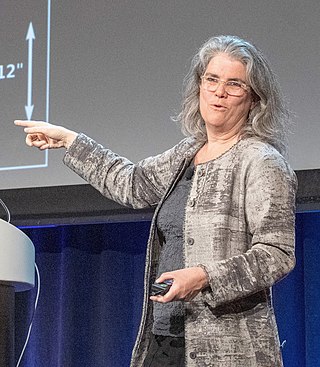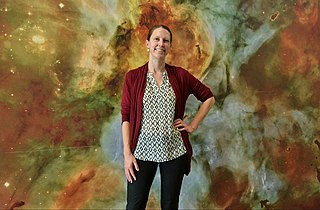Related Research Articles
Marc Aaronson was an American astronomer.

The American Astronomical Society is an American society of professional astronomers and other interested individuals, headquartered in Washington, DC. The primary objective of the AAS is to promote the advancement of astronomy and closely related branches of science, while the secondary purpose includes enhancing astronomy education and providing a political voice for its members through lobbying and grassroots activities. Its current mission is to enhance and share humanity's scientific understanding of the universe as a diverse and inclusive astronomical community.

Eleanor Margaret Burbidge, FRS (née Peachey; 12 August 1919 – 5 April 2020) was a British-American observational astronomer and astrophysicist. In the 1950s, she was one of the founders of stellar nucleosynthesis and was first author of the influential B2FH paper. During the 1960s and 1970s she worked on galaxy rotation curves and quasars, discovering the most distant astronomical object then known. In the 1980s and 1990s she helped develop and utilise the Faint Object Spectrograph on the Hubble Space Telescope. Burbidge was also well known for her work opposing discrimination against women in astronomy.
The Newton Lacy Pierce Prize in Astronomy is awarded annually by the American Astronomical Society to a young astronomer for outstanding achievement in observational astronomical research. The prize is named after Newton Lacy Pierce, an American astronomer.

Andrea Mia Ghez is an American astrophysicist, Nobel laureate, and professor in the Department of Physics and Astronomy and the Lauren B. Leichtman & Arthur E. Levine chair in Astrophysics, at the University of California, Los Angeles. Her research focuses on the center of the Milky Way galaxy.

Virginia Louise Trimble is an American astronomer specializing in the structure and evolution of stars and galaxies, and the history of astronomy. She has published more than 600 works in Astrophysics, and dozens of other works in the history of other sciences. She is famous for an annual review of astronomy and astrophysics research that was published in the Publications of the Astronomical Society of the Pacific, and often gives summary reviews at astrophysical conferences. In 2018, she was elected a Patron of the American Astronomical Society, for her many years of intellectual, organizational, and financial contributions to the society.
Amy J. Barger is an American astronomer and Henrietta Leavitt Professor of Astronomy at the University of Wisconsin–Madison. She is considered a pioneer in combining data from multiple telescopes to monitor multiple wavelengths and in discovering distant galaxies and supermassive black holes, which are outside of the visible spectrum. Barger is an active member of the International Astronomical Union.

Alexei Vladimir "Alex" Filippenko is an American astrophysicist and professor of astronomy at the University of California, Berkeley. Filippenko graduated from Dos Pueblos High School in Goleta, California. He received a Bachelor of Arts in physics from the University of California, Santa Barbara in 1979 and a Ph.D. in astronomy from the California Institute of Technology in 1984, where he was a Hertz Foundation Fellow. He was a postdoctoral Miller Fellow at Berkeley from 1984 to 1986 and was appointed to Berkeley's faculty in 1986. In 1996 and 2005, he a Miller Research Professor, and he is currently a Senior Miller Fellow. His research focuses on supernovae and active galaxies at optical, ultraviolet, and near-infrared wavelengths, as well as on black holes, gamma-ray bursts, and the expansion of the Universe.

William Nielsen Brandt is the Verne M. Willaman Professor of Astronomy & Astrophysics and a professor of physics at the Pennsylvania State University. He is best known for his work on active galaxies, cosmological X-ray surveys, starburst galaxies, normal galaxies, and X-ray binaries.
Lisa Jennifer Kewley is an Australian Astrophysicist and current Director of the Center for Astrophysics | Harvard & Smithsonian. Previously, Kewley was Director of the ARC Centre of Excellence for All Sky Astrophysics in 3-D and ARC Laureate Fellow at the Australian National University College of Physical and Mathematical Sciences, where she was also a Professor. Specialising in galaxy evolution, she won the Annie Jump Cannon Award in Astronomy in 2005 for her studies of oxygen in galaxies, and the Newton Lacy Pierce Prize in Astronomy in 2008. In 2014 she was elected a fellow of the Australian Academy of Science. In 2020 she received the James Craig Watson Medal. In 2021 she was elected as an international member of the National Academy of Sciences. In 2022 she became the first female director of the Center for Astrophysics | Harvard & Smithsonian.
Andrew Blain is a British astronomer and professor at the University of Leicester. He was previously assistant professor at California Institute of Technology.
Newton Lacy Pierce was an American astronomer.
Alan Michael Dressler is an American astronomer at the Carnegie Institution for Science of Washington, D.C. Among his works is the popularization Voyage To The Great Attractor: Exploring Intergalactic Space.

Heather A. Knutson is an astrophysicist and professor at California Institute of Technology in the Division of Geological and Planetary Sciences. Her research is focused on the study of exoplanets, their composition and formation. She won the American Astronomical Society's Newton Lacy Pierce Prize in Astronomy for her work in exoplanetary atmospheres.
Nadia Zakamska is a Russian-American astronomer who is a professor at Johns Hopkins University.
Harriet Dinerstein is an American astronomer. The American Astronomical Society honored her work by awarding her the Annie J. Cannon Prize in 1985. She also received the Newton Lacy Pierce Prize in 1989. Dinerstein received her Bachelor of Science degree from Yale University in 1975 and her Ph.D. from the University of California, Santa Cruz in 1980. She currently is a Professor of Astronomy at the University of Texas at Austin.
Elizabeth Lada is an American astronomer whose self-described research interests include "understanding the origin, properties, evolution and fate of young embedded clusters within molecular clouds".

Marcia Jean Rieke is an American astronomer. She is a Regents' Professor of Astronomy and associate department head at the University of Arizona. Rieke is the Principal Investigator on the near-infrared camera (NIRCam) for the James Webb Space Telescope (JWST). She has also served as the deputy-Principal Investigator on the Near Infrared Camera and Multi-Object Spectrometer (NICMOS) for the Hubble Space Telescope (HST), and as the co-investigator for the multiband imaging photometer on the Spitzer Space Telescope, where she also acted as an outreach coordinator and a member of the Science Working Group. Rieke was also involved with several infrared ground-based observatories, including the MMT Observatory in Arizona. She was vice chair for Program Prioritization of the Astro2010 Decadal Survey Committee, "New Worlds, New Horizons". Marcia Rieke is considered by many to be one of the "founding mothers" of infrared astronomy, along with Judith Pipher.
Linda Siobhan Sparke is a British astronomer known for her research on the structure and dynamics of galaxies. She is a professor emerita of astronomy at the University of Wisconsin–Madison, and Explorers Program Scientist in the NASA Astrophysics Division.
Jacqueline K. (Jackie) Faherty is an American astronomer specializing in infrared astronomy and the observation of nearby stars and brown dwarfs, and known for her public outreach in space science. She works at the American Museum of Natural History as a senior scientist in the museum's Department of Astrophysics and a senior education manager in the Department of Education.
References
- ↑ Nemeh, Katherine H., ed. (2020). "Sellgren, Kristen". American Men & Women of Science: A Biographical Directory of Today's Leaders in Physical, Biological, and Related Sciences. Vol. 18. Katherine H. Nemeh (38th ed.). Farmington Hills, Michigan: Gale. p. 10028. ISBN 978-0-02-866695-2. ISSN 0000-1287. OCLC 1152235791.
- ↑ "Newton Lacy Pierce Prize in Astronomy | American Astronomical Society". aas.org. Retrieved June 15, 2016.
- ↑ "Committee for Sexual-Orientation and Gender Minorities in Astronomy (SGMA) | SGMA". sgma.aas.org. Retrieved June 15, 2016.
- ↑ "Kris Sellgren's CV". www.astronomy.ohio-state.edu. Retrieved June 15, 2016.
- ↑ "Kristen Sellgren | Department of Astronomy". astronomy.osu.edu. Retrieved June 15, 2016.